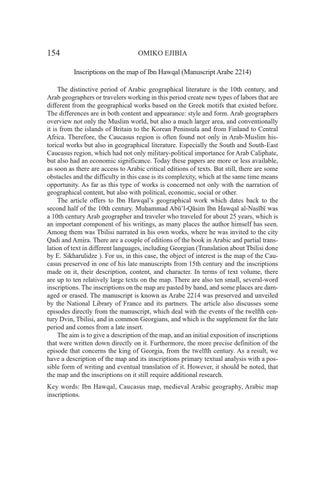154
OMIKO EJIBIA Inscriptions on the map of Ibn Hawqal (Manuscript Arabe 2214)
The distinctive period of Arabic geographical literature is the 10th century, and Arab geographers or travelers working in this period create new types of labors that are different from the geographical works based on the Greek motifs that existed before. The differences are in both content and appearance: style and form. Arab geographers overview not only the Muslim world, but also a much larger area, and conventionally it is from the islands of Britain to the Korean Peninsula and from Finland to Central Africa. Therefore, the Caucasus region is often found not only in Arab-Muslim historical works but also in geographical literature. Especially the South and South-East Caucasus region, which had not only military-political importance for Arab Caliphate, but also had an economic significance. Today these papers are more or less available, as soon as there are access to Arabic critical editions of texts. But still, there are some obstacles and the difficulty in this case is its complexity, which at the same time means opportunity. As far as this type of works is concerned not only with the narration of geographical content, but also with political, economic, social or other. The article offers to Ibn Hawqal’s geographical work which dates back to the second half of the 10th century. Muḥammad Abū’l-Qāsim Ibn Ḥawqal al-Naṣībī was a 10th century Arab geographer and traveler who traveled for about 25 years, which is an important component of his writings, as many places the author himself has seen. Among them was Tbilisi narrated in his own works, where he was invited to the city Qadi and Amira. There are a couple of editions of the book in Arabic and partial translation of text in different languages, including Georgian (Translation about Tbilisi done by E. Sikharulidze ). For us, in this case, the object of interest is the map of the Caucasus preserved in one of his late manuscripts from 15th century and the inscriptions made on it, their description, content, and character. In terms of text volume, there are up to ten relatively large texts on the map. There are also ten small, several-word inscriptions. The inscriptions on the map are pasted by hand, and some places are damaged or erased. The manuscript is known as Arabe 2214 was preserved and unveiled by the National Library of France and its partners. The article also discusses some episodes directly from the manuscript, which deal with the events of the twelfth century Dvin, Tbilisi, and in common Georgians, and which is the supplement for the late period and comes from a late insert. The aim is to give a description of the map, and an initial exposition of inscriptions that were written down directly on it. Furthermore, the more precise definition of the episode that concerns the king of Georgia, from the twelfth century. As a result, we have a description of the map and its inscriptions primary textual analysis with a possible form of writing and eventual translation of it. However, it should be noted, that the map and the inscriptions on it still require additional research. Key words: Ibn Hawqal, Caucasus map, medieval Arabic geography, Arabic map inscriptions.
